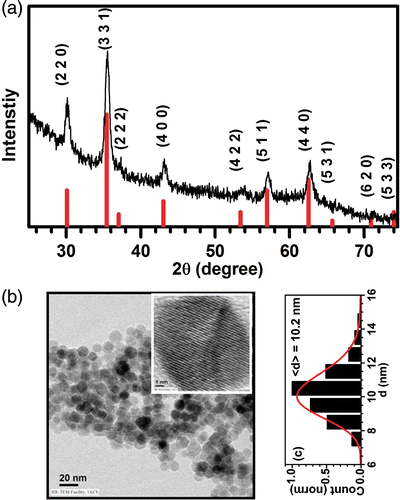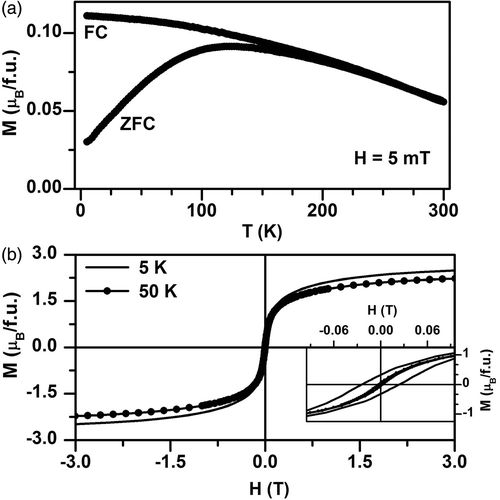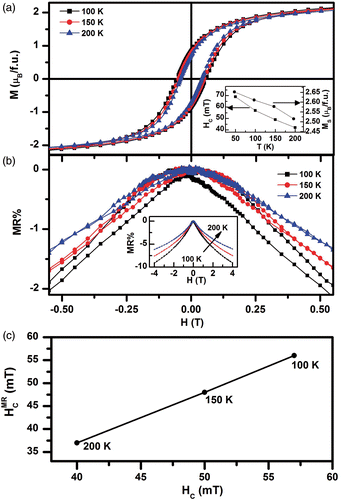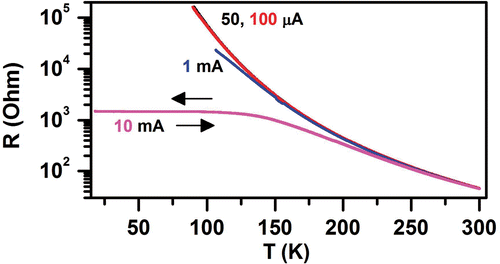Abstract
Nearly monodisperse spherical magnetite (Fe3O4) nanoparticles are prepared by colloidal chemistry route. Magnetic and electronic transport properties of the annealed pellets of these nanoparticles are reported. Effect of external magnetic and electric fields on the magnetic and transport properties of the material are studied as a function of temperature. We find that the highest resistance state of the ferromagnetic system occurs at a magnetic field which is approximately equal to its magnetic coercivity; this establishes the magnetoresistance (MR) in this system to be of the conventional tunnelling type MR as against the spin-valve type MR found more recently in some ferromagnetic oxide systems. The material also shows electroresistance (ER) property with its low-temperature resistance being strongly dependent on the excitation current that is used for the measurement. This ER effect is concluded to be intrinsic to the material and is attributed to the electric field-induced melting of the charge-order state in magnetite.
1. Introduction
Magnetite (Fe3O4) is probably the most explored and utilised magnetic material in the history of mankind. It is the first magnetic material that has been discovered by humans several centuries back. Yet, it is vastly investigated Citation1–4 even today because of the properties such as spin polarisation, biocompatibility of the material, etc. High degree of spin polarisation Citation5,Citation6 near the Fermi level makes it a good candidate for the study of tunnelling-type magnetoresistance (TMR). TMR is a phenomenon in which the electronic conduction between two ferromagnetic grains across an insulating barrier is controlled by the application of magnetic field Citation7. Magnetoresistance (MR), in general, has an important role in the development of present day memory devices like computer hard disk drives, flash memories and MRAMs Citation8. Another equally exciting phenomenon is the electroresistance (ER) that is reported Citation9–12 generally in transition metal oxides such as perovskite manganites and Ti-based oxides and it is expected to lead to modern memory devices Citation13. In a recent letter Citation14, Lee et al. reported the electric field-induced resistance switching in thin films of magnetite nanoparticles which is attributed to the charge-order breakdown in the presence of high local electric field. Lee et al. also suggest that the ER phenomenon in magnetite is possible only when the electrode separation is of the order of few microns so that the high enough electric field can be achieved locally even with regularly accessible voltage values. The origin of the ER phenomenon is, however, debatable Citation14 between the local joule heating effect and the electronic effects which are intrinsic to the material.
In the present manuscript, we report on the MR and ER effects in Fe3O4 nanoparticles which are prepared by colloidal chemistry route. The mean diameter of the magnetite particles studied is ∼10 nm. The annealed pellets of these nanoparticles show the MR and ER phenomena. We show that the magnetite system shows the ER effect even with the electrode separation being of the order of millimetre unlike what is suggested Citation14 previously. We also conclude that the ER effect is intrinsic and not related to the Joule heating effect. This intrinsic ER is attributed to the electric field-induced melting of the charge-order state Citation15 in magnetite.
2. Experimental section
The Fe3O4 nanoparticles are prepared by colloidal chemistry route Citation16,Citation17 using Fe-oleate as starting precursor. For this, 1 mmol of freshly prepared Citation16 Fe-oleate along with 1 mmol of oleic acid is taken in a three-necked flask in 40 mL of trioctylamine (TOA) solvent. This reaction solution is heated, under nitrogen atmosphere, to 320°C at 4°/min and held for 1.5 h with continuous stirring. The solution gradually turns to black in colour indicating the formation of magnetite nanoparticles. The magnetite particles are collected after a purification process which involves collecting TOA in acetone after dissolving and centrifugation. The particles are then dissolved in chloroform and re-precipitated in ethanol before centrifuging to get solid powder of nanoparticles sample. A part of this sample is pressed into 6 mm diameter pellets by cold pressing. The pellets are then annealed under Ar gas flow at 450°C for 2 h to remove organics from the surface of the particles and to ensure good inter-particle connectivity.
A Bruker D8 Advance X-ray diffractometer with Cu-Kα radiation is used to check the crystalline quality and phase purity of the prepared Fe3O4 nanoparticles. A JEOL High Resolution Transmission Electron Microscope (HRTEM) is used for checking the particle morphology, size and size distribution. Magnetic and magnetotransport properties were measured using Quantum design MPMS and PPMS systems. The current dependent resistance measurements are performed on a laboratory resistivity setup equipped with a closed cycle helium cryostat, wherein the temperature sensor is in close contact with the sample for accurate temperature monitoring. The magnetic properties are measured on both the as-obtained powders and on the pellets. The pellets are further used for measuring MR and ER effects. These measurements are performed by four probe method with the electrodes being separated by approximately 1.5 mm.
3. Results and discussion
In , we present the X-ray diffraction (XRD) pattern of the Fe3O4 nanoparticles. The comparison of the experimental XRD pattern with the standard JCPDF data (JCPDF card: No 19-0629, the vertical bars in red) proves that the sample forms in phase pure spinel structure and the sharp diffraction peaks indicate high crystalline quality of the particles. Debye–Scherrer's formula gives an average particle diameter of about 13 nm. HRTEM images in show nearly spherical particles of Fe3O4. Inset shows the high-resolution image of an individual particle with highly oriented crystal planes. Several TEM images are used for analysing the size distribution and the same is presented in . The histogram is well described by the lognormal distribution function, which is plotted as continuous line in the same figure. The mean particle diameter from this fitting is 10.2 nm, which somewhat differs from the XRD data as the broadening in XRD is also contributed by the presence of strain in the crystals and hence can lead to overestimation of particle diameters, therefore explaining the mismatch between the particle diameters from XRD and TEM analyses.
Figure 1. (Colour online) (a) The XRD pattern of the as prepared Fe3O4 nanoparticles is presented. In the same panel, the JCPDF data (red bars) is also presented for comparison. (b) The TEM image of the Fe3O4 nanoparticles with the inset showing the high-resolution image of a single particle. Panel (c) shows the particle size distribution and the lognormal fitting.

The magnetic data obtained on the as prepared powders of Fe3O4 are presented in , where panel (a) shows the field-cooled (FC) and zero-field-cooled (ZFC) magnetisation (M) measured as a function of temperature (T). For the ZFC measurement, the sample is cooled to 4 K in zero applied field and at 4 K, a field of 5 mT is applied and the magnetisation is measured while heating to 300 K. The FC magnetisation is measured while cooling the sample to 4 K in 5 mT applied field. The observed M(T) behaviour is a characteristic of superparamagnetic particles with a blocking temperature, T B, of ∼120 K. The hysteresis (M(H)) loops, measured at 5 and 50 K, are presented in . The magnetite particles have a coercivity of ∼25 mT at 5 K and a smaller, ∼2 mT, coercivity value at 50 K (inset of ). The magnetisation values, at 3 T applied field, are 2.5 and 2.24 μB/f.u. at 5 and 50 K, respectively. These values are comparable to the previously reported data Citation18. However, it is worth noting that the synthesis route used to prepare the magnetite particles is known to affect physical properties of the system such as the magnetisation. This arises due to differences in the quality of the nanoparticles and the stoichiometry at the particle surface. In cases where a substantial magnetic dead layer exists at the nanoparticle surface, the magnetisation is observed to be less than the bulk saturation magnetisation Citation19.
Figure 2. (a) The FC and ZFC M(T) data are presented for as prepared Fe3O4 nanoparticles. The cooling and measuring magnetic field is set as 5 mT. Panel (b) shows the hysteresis (M(H)) loops at two different temperatures, 5 and 50 K. The low-field magnetisation data is presented as inset to distinguish the coercive field values.

We now focus on the magnetic and electronic transport properties of the annealed pellets of Fe3O4 nanoparticles. shows the M(H) loops, at different temperatures. Expectedly, the M(H) loops measured on the pellet and powder form have largely different coercivity values with the pellet exhibiting a huge increase in coercivity compared to the powders. For example, the coercivity at 50 K increases from 2 mT in powder form to ∼70 mT in pellet form. This enhancement in coercivity is due to the increase in crystallite size of Fe3O4 due to the annealing of pellets at 450°C for 2 h. In the inset of , the temperature variation of the coercive field, H
C, and magnetisation at 3 T applied field, M
S, are presented. In , the MR% is plotted as a function of magnetic field (H), for different sample temperatures as indicated. The peak in the MR(H) curve represents a highest resistive state and also the lowest magnetised (or demagnetised) state in a system. We represent the field value at which such peak occurs by in this manuscript. One of the characteristics of conventional TMR structures is H
C ∼
,
value of the structure generally coincides Citation20,Citation21 with its magnetic coercivity, H
C, as the system is in demagnetised state at this field. This is demonstrated in a plot of H
C versus
in . Therefore, the homogeneous magnetite system behaves as a conventional TMR system and not as the recently reported spin-valve-type MR (SVMR) systems Citation22–24. The observed MR% (inset of ) values are in accordance with the previously reported values Citation25,Citation26 for the Fe3O4 bulk and the nanoparticle system Citation19,Citation27 showing that the prepared nanoparticles retain the full spin polarisation without any surface oxidation effects.
Figure 3. The panel (a) shows the hysteresis (M(H)) loops of the annealed pellets of Fe3O4 nanoparticles, at temperatures indicated. Inset shows the variation of coercive field, H
C and saturation magnetisation, M
S with temperature. In panel (b) the magnetoresistance (MR%) as a function of applied field (H) is plotted, at different temperatures. The inset shows the same plots for larger H-scale. The panel (c) presents the relation between and H
C at different temperatures, H
C ∼
.

shows the resistance (R) measured as a function of temperature (T) for four different excitation currents, 50 µA, 100 µA, 1 mA and 10 mA as indicated therein. The resistance is measured at constant current while cooling the sample from room temperature. The R(T) curves for lower current values (50 µA, 100 µA and 1 mA) are typical of the bulk Fe3O4 excepting the sharp jump in the resistivity at Verwey transition Citation28 temperature, T V ∼ 120 K. On cooling the sample from room temperature, the charge ordering Citation15 at T V takes the system to the insulating state from a semi-conducting state at higher temperatures. However, unlike in bulk magnetite material the nanoparticles do not show Citation14 a sharp jump in the resistivity at a specific temperature but gradually move to the insulating state as is also observed in our experiments. The absence of a sharp jump in the nanoparticle system arises due to dominating contact resistance between the particles Citation14. Nevertheless, with low excitation currents the material goes to highly insulating state at temperatures below 100 K, making it impossible to measure the resistance with normal four-probe method. An important and interesting observation in these R(T) measurements is the occurrence of ER phenomenon in this material, that is the resistance of the material is strongly dependent on the strength of current used for the measurement. The resistance of the material at low temperature is lowered by orders of magnitude when a higher (10 mA curve in ) excitation current is used for the measurement. This is equivalent of the resistance switching phenomenon that is usually observed in other transition metal oxides Citation9–12 and also as reported by Lee et al. Citation14 for the magnetite nanoparticle films. This excitation current-dependent resistance state of the Fe3O4 material can be attributed to the influence of electric field on the intrinsic charge ordered state. The upward and downward temperature scans (indicated by forward and backward arrows in ) with 10 mA excitation current does not show any thermal hysteresis that is expected in case the local joule heating effect is prominent Citation29. In addition, we do not see any abnormal changes in the sample temperature that are indicative of joule heating, even though in our experimental setup the temperature sensor is separated only by a thin sapphire plate from the sample. Any raise in the sample temperature should be sensed by the temperature sensor as both the magnetite and sapphire are good thermal conductors, especially at low temperatures. Therefore, we believe that this ER phenomenon is intrinsic to the sample and is not a result of local joule heating effect. In addition, we have also demonstrated that the ER effect in magnetite is observable even when the separation between the electrodes is larger than what is previously suggested.
Figure 4. The resistance (R) as a function of temperature (T) measured with four different excitation currents (50 µA, 100 µA, 1 mA and 10 mA) is plotted. It is to be noted that the data for the first two excitation currents fall on each other. The arrows for the 10 mA curve represent the temperature scanning direction.

4. Conclusion
Magnetic properties of magnetite nanoparticles prepared by colloidal chemistry route are presented. The annealed pellets of these nanoparticles are shown to exhibit MR and ER phenomenon. The observed MR is of tunnelling type because of the high degree of spin polarisation of the magnetite. The resistance is observed to be strongly affected by the value of excitation current used for the measurement. This ER is attributed to the electric field-induced melting of the charge-order state which is intrinsic to the magnetite.
Acknowledgements
The authors acknowledge Department of Science and Technology, Government of India, for the financial support; SR acknowledges DST Fast Track for financial support and DDS acknowledges the support of Council of Scientific and Industrial Research, Government of India.
References
- Majewski , P and Thierry , B . 2007 . Functionalized magnetite nanoparticles – Synthesis, properties, and bio-applications . Crit. Rev. Solid State Mater. Sci. , 32 : 203 – 215 . doi: 10.1080/10408430701776680
- Ogale , SB , Ghosh , K , Sharma , RP , Greene , RL , Ramesh , R and Venkatesan , T . 1998 . Magnetotransport anisotropy effects in epitaxial magnetite (Fe3O4) thin films . Phys. Rev. B , 57 : 7823 – 7828 . doi: 10.1103/PhysRevB.57.7823
- Chandra , V , Park , J , Chun , Y , Lee , JW , Hwang , I-C and Kim , KS . 2010 . Water-dispersible magnetite-reduced graphene oxide composites for arsenic removal . ACS Nano , 4 : 3979 – 3986 . doi: 10.1021/nn1008897
- Dung , TT , Danh , TM , Hoa , LTM , Chien , DM and Duc , NH . 2009 . Structural and magnetic properties of starch-coated magnetite nanoparticles . J. Exp. Nanosci. , 4 : 259 – 267 . doi: 10.1080/17458080802570609
- Liu , H , Jiang , EY , Bai , HL , Zheng , RK , Wei , HL and Zhang , XX . 2003 . Large room-temperature spin-dependent tunneling magnetoresistance in polycrystalline Fe3O4 films . Appl. Phys. Lett. , 83 : 3531 – 3533 . doi: 10.1063/1.1622440
- Fonin , M , Dedkov , Y , Konig , C , Guntherodt , G , Rudiger , U , Mayer , J , Vyalikh , D and Molodtsov , S . 2003 . Room temperature spin polarization of epitaxial half-metallic Fe3O4(111) and CrO2(100) films . Adv. Solid State Phys. , 43 : 487 – 503 . doi: 10.1007/b12017
- Julliere , M . 1975 . Tunneling between ferromagnetic films . Phys. Lett. A , 54 : 225 – 226 . doi: 10.1016/0375-9601(75)90174-7
- Wolf , SA , Awschalom , DD , Buhrman , RA , Daughton , JM , von Molnar , S , Roukes , ML , Chtchelkanova , AY and Treger , DM . 2001 . Spintronics: A spin-based electronics vision for the future . Science , 294 : 1488 – 1495 . doi: 10.1126/science.1065389
- Wu , T , Ogale , SB , Garrison , JE , Nagaraj , B , Biswas , A , Chen , Z , Greene , RL , Ramesh , R , Venkatesan , T and Millis , AJ . 2001 . Electroresistance and electronic phase separation in mixed-valent manganites . Phys. Rev. Lett. , 86 : 5998 – 6001 . doi: 10.1103/PhysRevLett.86.5998
- Choi , BJ , Jeong , DS , Kim , SK , Rohde , C , Choi , S , Oh , JH , Kim , HJ , Hwang , CS , Szot , K , Waser , R , Reichenberg , B and Tiedke , S . 2005 . Resistive switching mechanism of TiO2 thin films grown by atomic-layer deposition . J. Appl. Phys. , 98 : 033715-1 – 033715-10 . doi: 10.1063/1.2001146
- Odagawa , A , Sato , H , Inoue , IH , Akoh , H , Kawasaki , M , Tokura , Y , Kanno , T and Adachi , H . 2004 . Colossal electroresistance of a Pr0.7Ca0.3MnO3 thin film at room temperature . Phys. Rev. B , 70 : 224403-1 – 224403-4 . doi: 10.1103/PhysRevB.70.224403
- Sawa , A . 2008 . Resistive switching in transition metal oxides . Mater. Today , 11 : 28 – 36 . doi: 10.1016/S1369-7021(08)70119-6
- Waser , R and Aono , M . 2007 . Nanoionics-based resistive switching memories . Nature Mater. , 6 : 833 – 840 . doi: 10.1038/nmat2023
- Lee , S , Fursina , A , Mayo , JT , Yavuz , CT , Colvin , VL , Sofin , RGS , Shvets , IV and Natelson , D . 2008 . Electrically driven phase transition in magnetite nanostructures . Nature Mater. , 7 : 130 – 133 . doi: 10.1038/nmat2084
- Wright , JP , Attfield , JP and Radaelli , PG . 2001 . Long range charge ordering in magnetite below the Verwey transition . Phys. Rev. Lett. , 87 : 266401-1 – 266401-4 . doi: 10.1103/PhysRevLett.87.266401
- Jana , NR , Chen , YF and Peng , XG . 2004 . Size- and shape-controlled magnetic (Cr, Mn, Fe, Co, Ni) oxide nanocrystals via a simple and general approach . Chem. Mater. , 16 : 3931 – 3935 . doi: 10.1021/cm049221k
- Park , J , An , KJ , Hwang , YS , Park , JG , Noh , HJ , Kim , JY , Park , JH , Hwang , NM and Hyeon , T . 2004 . Ultra-large-scale syntheses of monodisperse nanocrystals . Nature Mater. , 3 : 891 – 895 . doi: 10.1038/nmat1251
- Goya , GF , Berquo , TS , Fonseca , FC and Morales , MP . 2003 . Static and dynamic magnetic properties of spherical magnetite nanoparticles . J. Appl. Phys. , 94 : 3520 – 3528 . doi: 10.1063/1.1599959
- Venkatesan , M , Nawka , S , Pillai , SC and Coey , JMD . 2003 . Enhanced magnetoresistance in nanocrystalline magnetite . J. Appl. Phys. , 93 : 8023 – 8025 . doi: 10.1063/1.1555371
- Coey , JMD , Berkowitz , AE , Balcells , L , Putris , FF and Barry , A . 1998 . Magnetoresistance of chromium dioxide powder compacts . Phys. Rev. Lett. , 80 : 3815 – 3818 . doi: 10.1103/PhysRevLett.80.3815
- Li , XW , Gupta , A , Xiao , G and Gong , GQ . 1997 . Low-field magnetoresistive properties of polycrystalline and epitaxial perovskite manganite films . Appl. Phys. Lett. , 71 : 1124 – 1126 . doi: 10.1063/1.119747
- Sarma , DD , Ray , S , Tanaka , K , Kobayashi , M , Fujimori , A , Sanyal , P , Krishnamurthy , HR and Dasgupta , C . 2007 . Intergranular magnetoresistance in Sr2FeMoO6 from a magnetic tunnel barrier mechanism across grain boundaries . Phys. Rev. Lett. , 98 : 157205-1 – 157205-4 . doi: 10.1103/PhysRevLett.98.157205
- Ray , S , Middey , S , Jana , S , Banerjee , A , Sanyal , P , Rawat , R , Gregoratti , L and Sarma , DD . 2011 . Origin of the unconventional magnetoresistance in Sr2FeMoO6 . Europhys. Lett. , 94 : 47007-1 – 47007-6 . doi: 10.1209/0295-5075/94/47007
- Jana , S , Middey , S and Ray , S . 2010 . Spin-valve-type magnetoresistance: A generic feature of ferromagnetic double perovskites . J. Phys. Condens. Matter , 22 : 346004-1 – 346004-7 . doi: 10.1088/0953-8984/22/34/346004
- Coey , JMD , Berkowitz , AE , Balcells , L , Putris , FF and Parker , FT . 1998 . Magnetoresistance of magnetite . Appl. Phys. Lett. , 72 : 734 – 736 . doi: 10.1063/1.120859
- Li , XW , Gupta , A , Xiao , G and Gong , GQ . 1998 . Transport and magnetic properties of epitaxial and polycrystalline magnetite thin films . J. Appl. Phys. , 83 : 7049 – 7051 . doi: 10.1063/1.367547
- Liu , K , Zhao , L , Klavins , P , Osterloh , FE and Hiramatsu , H . 2003 . Extrinsic magnetoresistance in magnetite nanoparticles . J. Appl. Phys. , 93 : 7951 – 7953 . doi: 10.1063/1.1556133
- Verwey , EJW and Haayman , PW . 1941 . Electronic conductivity and transition point of magnetite (“Fe3O4”) . Physica , 8 : 979 – 987 . doi: 10.1016/S0031-8914(41)80005-6
- Kumar , A and Dho , J . 2011 . Magneto- and electro-resistance effects in phase separated Pr0.55(Ca0.65S0.35)0.45MnO3 films . J. Appl. Phys. , 110 : 093901-1 – 093901-6 . doi: 10.1063/1.3656456
